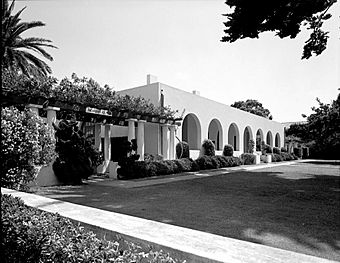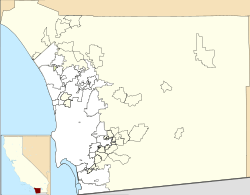La Jolla Woman's Club facts for kids
Quick facts for kids |
|
|
La Jolla Woman's Club
|
|

The western (front) side of the La Jolla Woman's Club
|
|
| Location | 715 Silverado St., La Jolla, California |
|---|---|
| Area | 0.6 acres (0.24 ha) |
| Built | 1914 |
| Architect | Irving John Gill |
| NRHP reference No. | 74000546 |
| Added to NRHP | November 5, 1974 |
The La Jolla Woman's Club is a special historic building in La Jolla, a neighborhood in San Diego, California. A famous architect named Irving Gill designed and built it with help from his nephew, Louis John Gill. This happened between 1914 and 1915. The building is a great example of Gill's unique modern style of architecture. It is so important that it is listed on the National Register of Historic Places. This means it is recognized as a significant historical site.
A Look Back: The Club's Story
The La Jolla Woman's Club started a long time ago in 1894. Back then, it was called the Current Events Club. It changed its name to the La Jolla Woman's Club in 1900. For the first 20 years, the club did not have its own building. The first stone of the building was placed in December 1913. The club held its first meeting in the new building in 1914.
Building Design and Construction
A kind person named Ellen Browning Scripps helped the club a lot. She was a club member and a philanthropist, which means she gave money to good causes. Ellen Scripps donated the land, the design, and even the construction of the clubhouse. The whole project cost about $40,000.
This building is a perfect example of Irving Gill's modern style. His designs often used simple shapes like squares and rectangles. He also used many arches and columns. Gill liked to keep things simple, so there was very little decoration. People sometimes call his style "shaved Spanish." This is because it looks a bit like the old Spanish buildings in California. It especially looks like the California missions. Gill's buildings often had flat roofs and no fancy details.
Gill also tried out a new way to build with concrete. It was called the "tilt-wall" method. Workers would pour concrete onto a large table. This table was tilted at a slight angle. Once the concrete was dry, they would lift the wall into place. Then, they would fit the windows into the new wall.
Inside the building, you can see Gill's ideas about cleanliness. There are no baseboards or fancy trims. Gill believed these details could trap dust and dirt. Many people think the La Jolla Woman's Club is one of Gill's best works.
National Recognition
The La Jolla Woman's Club was added to the National Register of Historic Places in 1974. This means it is officially recognized as a historic landmark. There are other famous buildings in La Jolla designed by Irving Gill too. These include The Bishop's School and the La Jolla Recreation Center. You can visit the clubhouse on Saturdays. It is open from 9:00 am to noon.





